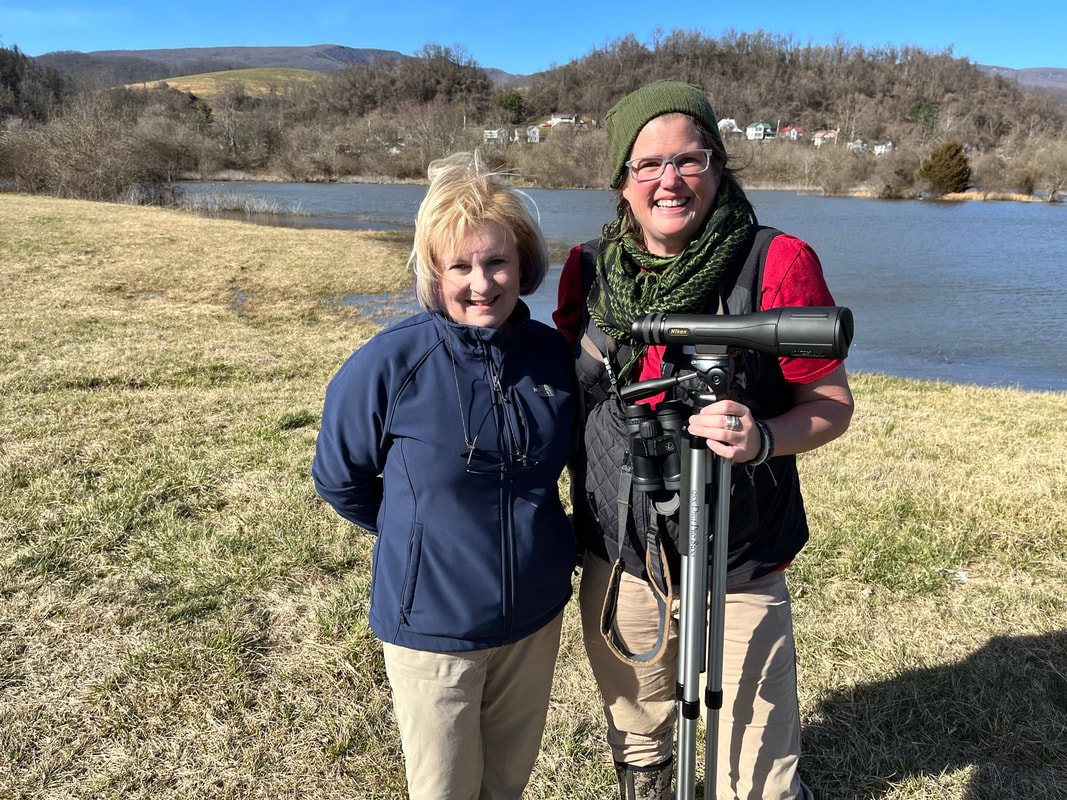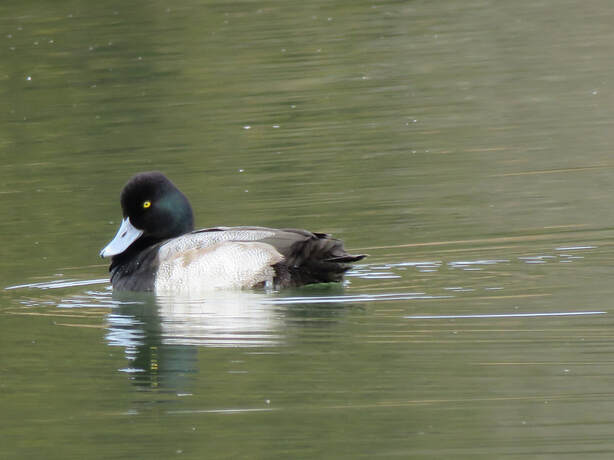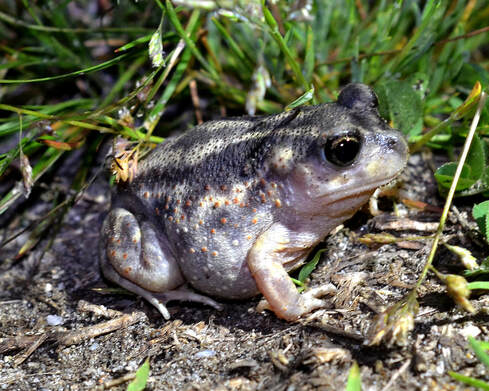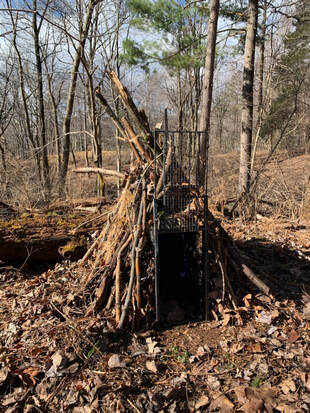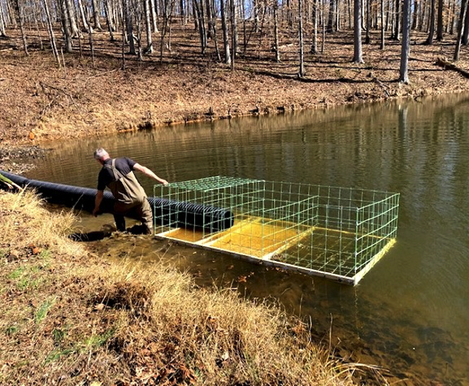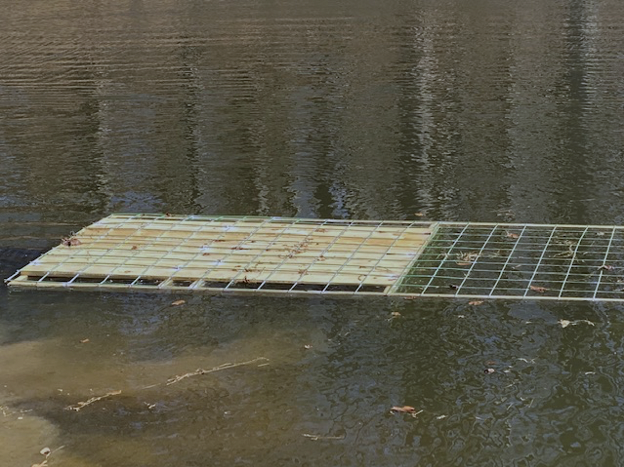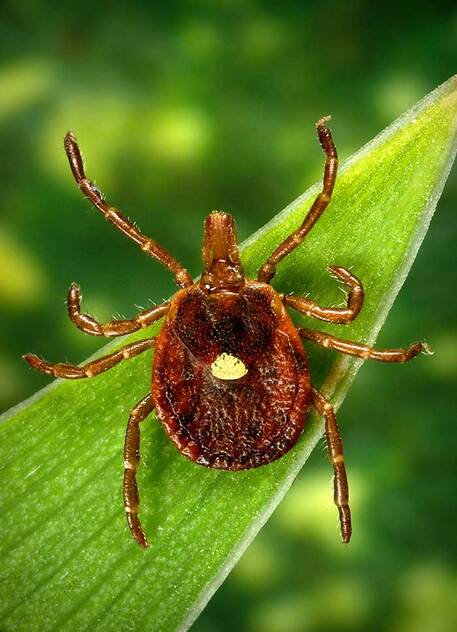Laurels – Spring 2023
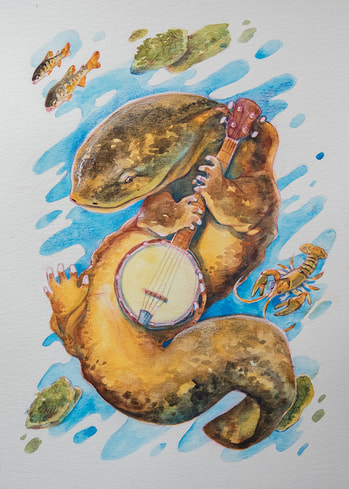 “Please Don’t Roll My Rocks” by Virginia Greene is the artwork for the next Restore the Wild sticker from VDWR.
“Please Don’t Roll My Rocks” by Virginia Greene is the artwork for the next Restore the Wild sticker from VDWR.
By night (at least on Tuesdays this spring), Sarah Foster is a VMN trainee in the Headwaters Chapter, learning all about natural history and natural resource management. By day, she teaches Family and Consumer Sciences to students at Beverly Manor Middle School. This spring, she was recognized as one of the August County Schools Teachers of the Year! In her teaching, Sarah strives to make learning as hands-on as possible. We are looking forward to her combining her teaching talent with her developing naturalist expertise to be a wonderful VMN volunteer!
Also bringing personal talents to the Headwaters Chapter is current trainee Virginia Greene. Her original watercolor, “Please Don’t Roll My Rocks” was chosen by a panel of judges to be the artwork for the annual Restore the Wild sticker from the Virginia Department of Wildlife Resources. Virginia also has a day job that connects with the VMN program–she’s the South River Restoration Projects Specialist with the Virginia Natural Heritage Program.
Congratulations, Sarah and Virginia, and thank you for all the talent you bring to the VMN program!
–Submitted by Susan McSwain, VMN-Central Blue Ridge Chapter
The Central Virginia Land Conservancy (CVALC) works with landowners in the counties of Amherst, Appomattox, Buckingham, Campbell, and Nelson who want to protect their land through the use of conservation easements. On April 22, the organization celebrated its 20th anniversary at a dinner event held in the City of Bedford. At the event, CVALC’s highest award – the Conservation Cornerstone Award – was presented to a volunteer with an impressive history of communicating with landowners throughout the area about the importance of preserving farms and forests for future generations.
The volunteer recognized was Wendy Kendrick, who is a member of the Central Blue Ridge chapter. She serves as an at-large board member for the chapter, but long before she became a Virginia Master Naturalist volunteer, Wendy was already active with CVALC.
In 2003, Wendy co-founded CVALC, and she has served on the organization’s board since that year, including a long stint as president. Over the years, she has spoken with hundreds of landowners about conservation and open space easements as a means to protect their land from subdivision and development. Her work has included organizing informative indoor workshops as well as on-the-ground visits to properties throughout central Virginia.
Wendy also serves on the board of the Blue Ridge Land Conservancy (BRLC) that covers Botetourt, Craig, Floyd, Franklin, Montgomery, and Roanoke counties. She helps monitor land under easement for both CVALC and BRLC and she is part of the stewardship committee for BRLC. As if that was not enough, she has even been known to volunteer with the Southern Virginia Land Conservancy, which operates in Patrick, Henry, Pittsylvania and Halifax counties. Her own farm in Amherst County has been under an open-space easement with the Virginia Outdoors Foundation since 2003.
As a Virginia Master Naturalist volunteer, Wendy serves as an at-large board member for the Central Blue Ridge chapter. She regularly volunteers with the James River Association on stream buffer planting and invasives removal projects, and she has also helped plant a stream buffer in Nelson County organized by the VA Department of Forestry. Anyone who appreciates the rich biological heritage of Virginia, with its beautiful vistas of forests and farms, can thank people whose efforts often take place “behind” those bucolic scenes.
Thank you, Wendy!
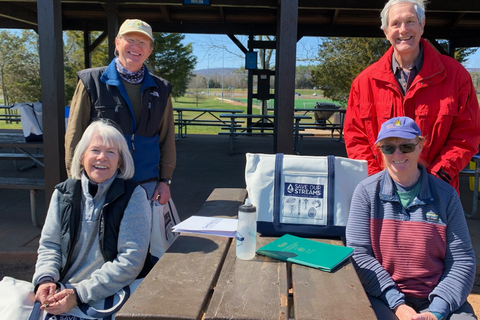 Top row left – Jere Willis, right – Mike Wenger; bottom row left – Linda Lowery, right – Lynne Leeper. Photo by Kris Jarvis.
Top row left – Jere Willis, right – Mike Wenger; bottom row left – Linda Lowery, right – Lynne Leeper. Photo by Kris Jarvis.
–Contributed by Charlene Uhl, VMN-Old Rag Chapter
Virginia Save Our Streams (VASOS) is a program of the Izaak Walton League of America. VASOS recruits people to become certified monitors. These certified monitors then help local volunteer efforts to assess the health of local streams. Volunteer monitors must use a set method to net, sort and count bottom dwelling “macroinvertebrates” whose presence (or absence) serves as an indicator of overall stream health. Certified monitors work with these volunteers, to assure the correct protocol is used in order to ensure data collected are accurate and can be included in the local and national data base.
Four Old Rag Master Naturalists – Linda Lowery and Lynne Leeper from Fauquier County and Jere Willis and Mike Wenger from Rappahannock County – completed the field portion of the program in April. They had gained experience last year by teaching the protocol to members of ORMN’s Basic Training Class. Most of the stream sites that ORMN members monitor exhibit a health biological mix of sensitive organisms such as mayflies and stoneflies and more tolerant species like black fly larva.
Their training also included a session with Kria Carney from Virginia Save Our Streams and some people from other stream monitoring programs. This included going over the protocols and procedures for training future stream monitors. They received informational materials to use in training as well as discussions on how to handle a variety of situations.
With the completion of their field work, these four ORMN members
are now able to work with other ORMN members who want to become certified monitors – essentially our own training team! In order to maintain their Trainer Certification they have to train and certify at least one new monitor a year, which they can do as a group. They hope that some Class XII members will be interested in the program and join them.
The expertise that our four ORMN members offer is a valuable resource to our community and an important aid to Master Naturalist efforts to promote healthy streams. ORMN applauds their commitment to this important role!
–Contributed by Dorie Stolley, DCR State Parks
In 2022, Virginia Master Naturalist volunteers contributed 11,609 hours of service in more than 25 Virginia State Parks. Virginia Master Naturalists are some of the most dedicated park volunteers! Several of them were recently recognized with Virginia State Parks Volunteer of the Year awards. Here’s more about each of them and the work they do in the parks, as written by their nominators. In addition, Randy Smith (formerly a VMN in the Holston Rivers Chapter) was awarded the Lifetime Achievement award, posthumously, for all of his work at Hungry Mother State Park.
Jack and Theresa Rayburn (VMN-Pocahontas Chapter, winners of the Individual – Exceptional Service award for their work at Westmoreland State Park) – “This volunteer duo self-describes their duties as “whatever benefits the park the most”. I have yet to discover any task these two aren’t willing to help out with. The rayburns regularly conduct beach cleanups, interpretive programming, park maintenance, assist with special events, manage native/invasive plant species, monitor and encourage pollinator activity, build park signage and structures, and perform camp host duties- even prior to registering as camp hosts.”
April Allen (VMN-Southern Piedmont Chapter, runner-up for the Individual – Interpretation award for her work at Staunton River Battlefield State Park) – “The ranger-led programs she provides continue to be well received. One of the best examples of her stellar character to devotion of our park’s mission, and the mission for Virginia State Parks, was in November when the park received a school field trip numbering eighty 2nd Graders and teachers. April stepped up, stuck it out the entire day, and was an essential part to the memories generated for those school children, who had not had a field trip adventure in over two years.”
Randy Bagby (VMN-Southern Piedmont Chapter, winner of the Individual – Exceptional Service award for his work at Occoneechee State Park) – “As the trail steward for our most extensive trail, The Panhandle Multi-use trail. Randy’s regular duties include a weekly check of the trail for fallen limbs, trees, and debri; the collection of litter along this trail; completing duties associated with the Friends of Occoneechee State Park; assisting park staff with pollinator field management; and working with staff to complete the Sawyer Apprentice program.”
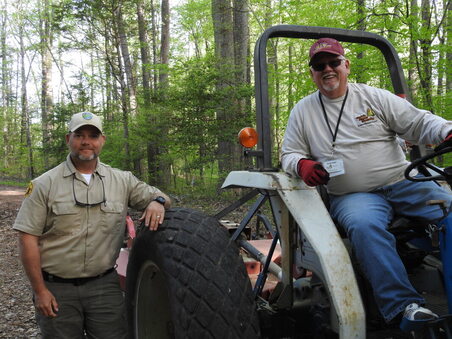 Randy Bagby (VMN-Southern Piedmont Chapter) and Occoneechee State Park Ranger Brandon Brown at work. Photo by Terri Mewborn (VMN-Southern Piedmont Chapter).
Randy Bagby (VMN-Southern Piedmont Chapter) and Occoneechee State Park Ranger Brandon Brown at work. Photo by Terri Mewborn (VMN-Southern Piedmont Chapter).
–Contributed by Terri Mewborn, VMN-Southern Piedmont Chapter
From the very get-go, Randy Bagby has been extraordinary in his devotion and service to the Southern Piedmont Chapter and to Virginia State Parks. Randy trained and certified with this new chapter’s inaugural Basic Training class in 2022. Since then, he has volunteered in several different project areas, including stewardship, citizen science, and chapter admin. Randy is always willing to lend a hand anywhere he’s needed, and his service in Virginia’s State Parks is particularly noteworthy. Since January, Randy has logged over 150 hours, including 120 at Staunton River and Occoneechee State Parks. His work at two of the Southern Piedmont’s three state parks demonstrates both his love of the parks and personal commitment to service. Randy has trained for operating heavy equipment and chainsaws, so for him, trail stewardship goes well beyond clearing storm blowdown and removing invasive plants and litter. Plus, he never misses an opportunity to engage with park visitors as an ambassador both for VMN and VSP.
State Park staff are thrilled to have Randy on their team:
“Randy Bagby has been working with Occoneechee State Park for the past year,” says Chief Ranger Austin Peightel, “From the moment of his arrival, he has been a dependable and ambitious volunteer. Randy does not hesitate to accomplish any task and does so with an enthusiasm that is contagious to other volunteers and park staff alike. During the past year he has been working to restore the Panhandle Trail system. He has been vital in our ability to reopen corridors along the trail that had been previously lost to succession. Not only has he played a vital role on the Panhandle trail, but Randy has frequently sought out other opportunities to aid the park in all areas and departments. Some examples include invasive species abatement, pollinator field maintenance, sawyer operations, group volunteer involvement and volunteer recruiting…Randy was one of the initial members of the newly founded Friends of Occoneechee State Park and continues to surprise and impress us with his kind heart and aptitude for service. We are extremely grateful for the work he has accomplished in the park, and even more so for the relationship we have formed with Randy Bagby. We look forward to many more years and many more projects.”
At Staunton River State Park, Chief Ranger Ben Issacs says, “Randy has been serving as a trail steward…for a little over a month. In that short time, he has played a crucial role in assisting park staff with the rehabilitation of an old hiking trail around the park’s private lake. He has pruned, sawed, rak
ed, blown leaves, weed-eated, and overall groomed this trail back to its former glory. The park will be utilizing this trail for a “Cops and Bobbers” kids’ fishing day with the South Boston Police Department, and without Randy’s help we never would have been able to get the trail ready in time. In helping us with this trail Randy has served this park and our local community! Randy showed up to the park one day and said, ‘I am here to help, put me to work,’ and we are so happy to have him on board.”
The Southern Piedmont Chapter is also very happy and proud to have Randy on board!
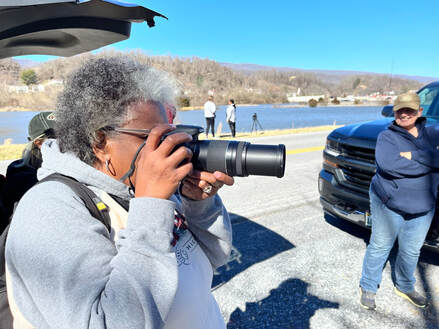 Both new and experienced birders got the opportunity to view a diversity of waterfowl and other species. Photo by VMN-Holston Rivers Chapter.
Both new and experienced birders got the opportunity to view a diversity of waterfowl and other species. Photo by VMN-Holston Rivers Chapter.
Contributed by Monica Hoel, VMN-Holston Rivers Chapter
The Holston Rivers chapter has been doing a lot of observations at DWR Bird and Wildlife site MCM02 — The Well Fields in Saltville. During Covid, volunteers logged many hours of observations in iNaturalist and eBird at that location in order to work together while staying physically apart. Now that restrictions are over, they are inviting the public, especially members of the Saltville community, to join them in enjoying the marvels of this fascinating DWRBWT area.
In February 2023, Holston Rivers members teamed up with the Emory & Henry Lifelong Learning program to offer a Sunday afternoon of birding information and observation. With 30 attendees for this very first event, program organizers were thrilled.
Saltville’s unique geography makes it a fascinating location for plants and geology, and even though these well fields are basically right in the middle of town the diversity of birds and other wildlife is remarkable. eBird lists 189 recorded bird species just in the well fields area, and there were some unique birds in attendance at this first event. The afternoon viewing revealed Northern Shovelers, Lesser Scaups, American Coots, Gadwalls, American Wigeons, Killdeer, and a Red-tailed Hawk among others. The crowd ranged in age from retirement to third grade, and participants were delighted. Most were new birders who were thrilled to see animals they had never noticed before, and they repeatedly asked for another opportunity soon.
The Smyth County Chamber of Commerce has invited HRVMN volunteers to repeat the event quarterly, and volunteers are excited to share more about what makes this spot so special.
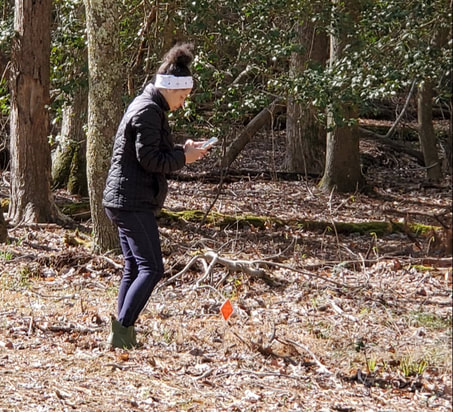 Amber Miller (VMN-Peninsula Chapter) conducting a biosurvey at Historic Endview in Newport News. Photo contributed by VMN-Peninsula Chapter.
Amber Miller (VMN-Peninsula Chapter) conducting a biosurvey at Historic Endview in Newport News. Photo contributed by VMN-Peninsula Chapter.
–Contributed by Daina Henry, VMN-Peninsula Chapter
Amber Miller, VMN-Peninsula Chapter, has been conducting a biosurvey at a local park, Historic Endview, in Newport News. She has gathered experts on herpetology from the Virginia Living Museum, Christopher Newport University, and Newport News Parks and Recreation. Their efforts have resulted in identifying two species of interest – the spadefoot toad and the woodland box turtle.
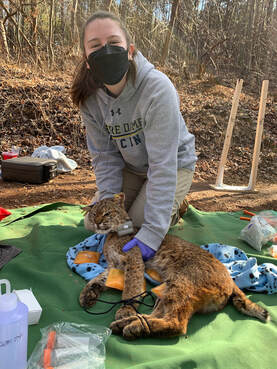 Virginia Tech graduate student Nicole Gorman with first bobcat captured. Photo contributed by Nicole Gorman, Virginia Tech.
Virginia Tech graduate student Nicole Gorman with first bobcat captured. Photo contributed by Nicole Gorman, Virginia Tech.
–Contributed by Leah Jung, VMN-Rivanna Chapter
Due to increased awareness of the importance of wildlife corridors and the persistence of a Rivanna Master Naturalist (Leah Jung), Virginia Tech recently funded a study of bobcat movement in Northwest Albemarle County. A graduate student was recruited and is currently setting live traps to capture bobcats and outfit them with satellite collars.
The collars will transmit movement data and this will be compared to the types of land used to determine bobcat habitat. Any corridors used to move across the land will be mapped. The data may also provide information on bobcat response to human activity and provide insight into how growth may impact bobcat behavior.
Bobcat were chosen for the study because their food sources (prey) and thus habitat needs are likely to reflect the habitat needs of a large variety of other wildlife. Landowners continue to be recruited for ‘hosting’ a live trap, local & state government officials are being informed, and other types of support are being achieved towards a goal of including scientific-informed decisions in county growth management.
Laurels – Spring 2023 Read Post »


